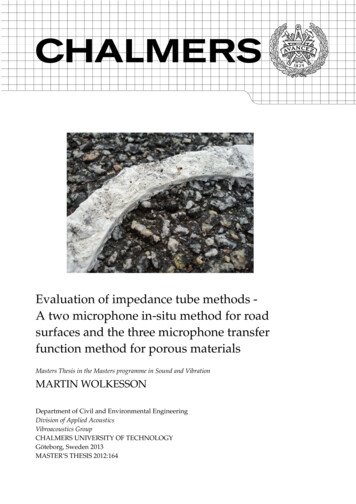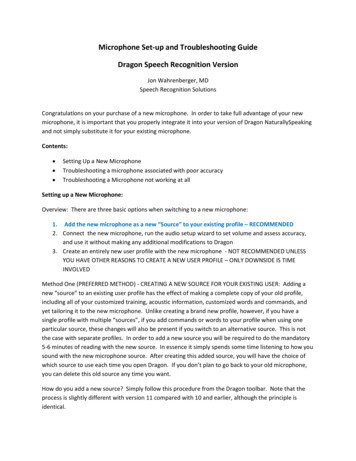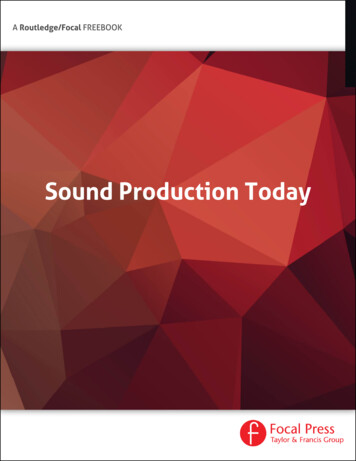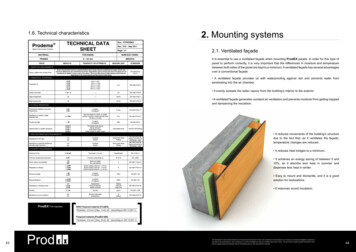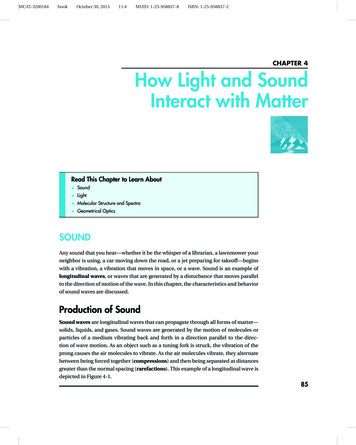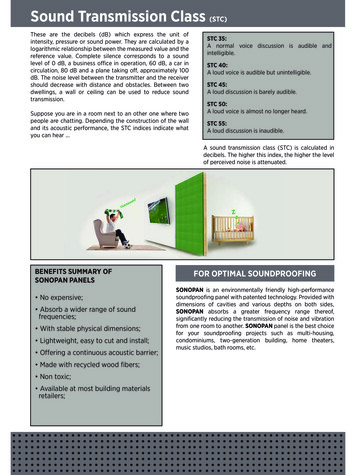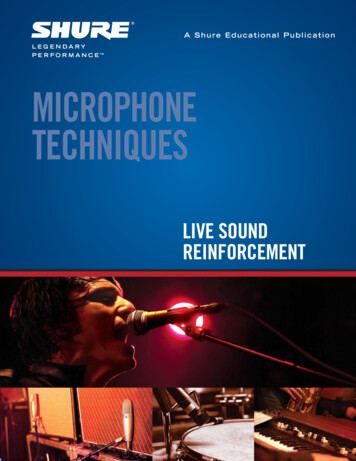
Transcription
A Shure Educational PublicationMICROPHONETECHNIQUESLIVE SOUNDREINFORCEMENT
Microphone TechniquesforLIVE SOUNDTa b l e o f C o n t e n t sIntroduction . 4Microphone Characteristics . 5Musical Instrument Characteristics. 11Acoustic Characteristics . 14Microphone Placement. 22Stereo Microphone Techniques. 32Microphone Selection Guide . 34Glossary . 35Live Sound3
Microphone TechniquesforLIVE SOUNDIntroductionMicrophone techniques (the selection and placement ofmicrophones) have a major influence on the audio qualityof a sound reinforcement system. For reinforcement ofmusical instruments, there are several main objectives ofmicrophone techniques: to maximize pick-up of suitablesound from the desired instrument, to minimize pick-up ofundesired sound from instruments or other sound sources,and to provide sufficient gain-before-feedback. “Suitable”sound from the desired instrument may mean either thenatural sound of the instrument or some particular soundquality which is appropriate for the application. “Undesired”sound may mean the direct or ambient sound from othernearby instruments or just stage and background noise.“Sufficient” gain-before-feedback means that the desiredinstrument is reinforced at the required level without ringingor feedback in the sound system.Obtaining the proper balance of these factors may involvea bit of give-and-take with each. In this guide, Shureapplication and development engineers suggest a variety ofmicrophone techniques for musical instruments to achievethese objectives. In order to provide some backgroundfor these techniques it is useful to understand some ofthe important characteristics of microphones, musicalinstruments and acoustics.Introduction4
Microphone TechniquesforLIVE SOUNDMicrophone CharacteristicsThe most important characteristics of microphones for livesound applications are their operating principle, frequencyresponse and directionality. Secondary characteristics aretheir electrical output and actual physical design.Operating principle - The type of transducer inside themicrophone, that is, how the microphone picks up soundand converts it into an electrical signal.A transducer is a device that changes energy from oneform into another, in this case, acoustic energy intoelectrical energy. The operating principle determines someof the basic capabilities of the microphone. The two mostcommon types are Dynamic and Condenser.Dynamic microphones employ a diaphragm/ voicecoil/magnet assembly which forms a miniature sounddriven electrical generator. Sound waves strike a thinplastic membrane (diaphragm) which vibrates in response.A small coil of wire (voice coil) is attached to the rear of thediaphragm and vibrates with it. The voice coil itselfis surrounded by amagnetic field createdby a small permanentmagnet. It is the motionof the voice coil in thismagnetic field whichgenerates the electricalsignal corresponding tothe sound picked up bya dynamic microphone.Dynamic microphones have relatively simple constructionand are therefore economical and rugged. They canprovide excellent sound quality and good specifications inall areas of microphone performance. In particular, theycan handle extremely high sound levels: it is almostimpossible to overload a dynamic microphone. In addition,dynamic microphones are relatively unaffected byextremes of temperature or humidity. Dynamics are thetype most widely used in general sound reinforcement.Condenser microphones are based on an electricallycharged diaphragm/backplate assembly which forms asound-sensitive capacitor. Here, sound waves vibrate avery thin metal or metal-coated-plastic diaphragm.The diaphragm is mounted just in front of a rigid metal ormetal-coated-ceramic backplate. In electrical terms thisassembly or element is known as a capacitor (historicallycalled a “condenser”),which has the ability to storea charge or voltage. Whenthe element is charged, anelectric field is createdbetween the diaphragm andthe backplate, proportionalto the spacing betweenthem. It is the variation ofthis spacing, due to themotion of the diaphragm relative to the backplate, thatproduces the electrical signal corresponding to the soundpicked up by a condenser microphone.The construction of a condenser microphone mustinclude some provision for maintaining the electricalcharge or polarizing voltage. An electret condensermicrophone has a permanent charge, maintained by aspecial material deposited on the backplate or on thediaphragm. Non-electret types are charged (polarized)by means of an external power source. The majority ofcondenser microphones for sound reinforcement are ofthe electret type.All condensers contain additional active circuitry to allowthe electrical output of the element to be used with typicalmicrophone inputs. This requires that all condensermicrophones be powered: either by batteries or byphantom power (a method of supplying power to amicrophone through the microphone cable itself). Thereare two potential limitations of condenser microphonesdue to the additional circuitry: first, the electronicsproduce a small amount of noise; second, there is a limitto the maximum signal level that the electronicscan handle. For this reason, condenser microphonespecifications always include a noise figure and amaximum sound level. Good designs, however, have verylow noise levels and are also capable of very widedynamic range.Condenser microphones are more complex than dynamicsand tend to be somewhat more costly. Also, condensersmay be adversely affected by extremes of temperature andhumidity which can cause them to become noisy or failtemporarily. However, condensers can readily be madewith higher sensitivity and can provide a smoother, morenatural sound, particularly at high frequencies. Flatfrequency response and extended frequency range aremuch easier to obtain in a condenser. In addition,condenser microphones can be made very small withoutsignificant loss of performance.5
Microphone TechniquesforLIVE SOUNDPhantom PowerPhantom power is a DC voltage (usually 12-48 volts)used to power the electronics of a condensermicrophone. For some (non-electret) condensers itmay also be used to provide the polariziing voltage forthe element tself. This voltage is supplied through themicrophone cable by a mixer equipped with phantompower or by some type of in-line external source. Thevoltage is equal on Pin 2 and Pin 3 of a typicalbalanced, XLR-type connector. For a 48 volt phantomsouorce, for example, Pin 2 is 48 VDC and Pin 3 is 48VDC, both with respect to Pin 1 which is ground (shield).Because the voltage is exactly the same on Pin 2 andPin 3, phantom power will have no effect on balanceddynamic microphones: no current will flow since thereis no voltage difference across the output. In fact,phantom power supplies have current limiting whichwill prevent damage to a dynamic microphone even ifit is shorted or miswired. In general, balanced dynamicmicrophones can be connected to phantom poweredmixer inputs with no problem.lightweight condenser diaphragm. It also takeslonger for the dynamic diaphragm to stop moving incomparison to the condenser diaphragm. Thus, thedynamic transient response is not as good as thecondenser transient response. This is similar to twovehicles in traffic: a truck and a sports car. They mayhave equal power engines but the truck weighsmuch more than the car. As traffic flow changes, thesports car can accelerate and brake very quickly,while the semi accelerates and brakes very slowlydue to its greater weight. Both vehicles follow theoverall traffic flow but the sports car responds betterto sudden changes.Pictured here are two studio microphonesresponding to the sound impulse produced by anelectric spark: condenser mic on top, dynamic micon bottom. It is evident that it takes almost twice aslong for the dynamic microphone to respond to thesound. It also takes longer for the dynamic to stopmoving after the impulse has passed (notice theripple on the second half of the graph). Sincecondenser microphones generally have bettertransient response then dynamics, they are bettersuited for instruments that have very sharp attackor extended high frequency output such ascymbals. It is this transient response differencethat causes condenser mics to have a more crisp,detailed sound and dynamic mics to have a moremellow, rounded sound.Transient ResponseTransient response refers to the ability of amicrophone to respond to a rapidly changing soundwave. A good way to understand why dynamic andcondenser mics sound different is to understand thedifferences in their transient response.In order for a microphone to convert sound energyinto electrical energy, the sound wave mustphysically move the diaphragm of the microphone.The amount of time it takes for this movement tooccur depends on the weight (or mass) of thediaphragm. For instance, the diaphragm and voicecoil assembly of a dynamic microphone may weighup to 1000 times more than the diaphragm of acondenser microphone. It takes longer for the heavydynamic diaphragm to begin moving than for the6Condenser/dynamic scope photo
Microphone TechniquesforLIVE SOUNDThe decision to use a condenser or dynamic microphonedepends not only on the sound source and the soundreinforcement system but on the physical setting as well.From a practical standpoint, if the microphone will be usedin a severe environment such as a rock and roll club or foroutdoor sound, dynamic types would be a good choice.In a more controlled environment such as a concert hallor theatrical setting, a condenser microphone might bepreferred for many sound sources, especially when thehighest sound quality is desired.Frequency response - The output level or sensitivity of themicrophone over its operating range from lowest to highestfrequency.Virtually all microphone manufacturers list the frequencyresponse of their microphones over a range, for example50 - 15,000 Hz. This usually corresponds with a graph thatindicates output level relative to frequency. The graph hasfrequency in Hertz (Hz) on the x-axis and relative responsein decibels (dB) on the y-axis.A microphone whose output is equal at all frequencies hasa flat frequency response.Flat response microphones typically have an extendedfrequency range. They reproduce a variety of soundsources without changing or coloring the original sound.A microphone whose response has peaks or dips in certainfrequency areas exhibits a shaped response.A shaped response is usually designed to enhance a soundsource in a particular application.For instance, a microphone may have a peak in the 2 - 8kHz range to increase intelligibility for live vocals. This shapeis called a presence peak or rise. A microphone may also bedesigned to be less sensitive to certain other frequencies.One example is reduced low frequency response (low endroll-off) to minimize unwanted “boominess” or stage rumble.The DecibelThe decibel (dB) is an expression often used in electricaland acoustic measurements. The decibel is a numberthat represents a ratio of two values of a quantity such asvoltage. It is actually a logarithmic ratio whose mainpurpose is to scale a large measurement range down toa much smaller and more useable range. The form ofthe decibel relationship for voltage is:dB 20 x log(V1/V2)where 20 is a constant, V1 is one voltage, V2 is theother voltage, and log is logarithm base 10.Examples:What is the relationship in decibels between100 volts and 1 volt?dB 20 x log(100/1)dB 20 x log(100)dB 20 x 2 (the log of 100 is 2)dB 40That is, 100 volts is 40dB greater than 1 volt.What is the relationship in decibels between0.001 volt and 1 volt?Flat frequency responsedB 20 x log(0.001/1)dB 20 x log(0.001)dB 20 x (-3) (the log of .001 is -3)dB -60That is, 0.001 volt is 60dB less that 1 volt.Similarly:if one voltage is equal to the other they are 0dB differentif one voltage is twice the other they are 6dB differentif one voltage is ten times the other they are 20dBdifferentShaped frequency response7
Microphone TechniquesforLIVE SOUNDSince the decibel is a ratio of two values, there mustbe an explicit or implicit reference value for anymeasurement given in dB. This is usually indicatedby a suffix on the decibel value such as: dBV(reference to 1 volt which is 0dBV) or dB SPL(reference to 0.0002 microbar which is 0dB SoundPressure Level)1. Compare2. Compress0bab/a10 1101 10102 100103 1000104 10,000105 100,000106 1,000,0003. scale (x 20)020406080100120Decibel scalefor dBV or dB SPLOne reason that the decibel is so useful in certainaudio measurements is that this scaling functionclosely approximates the behavior of human hearingsensitivity. For example, a change of 1dB SPL isabout the smallest difference in loudness that canbe perceived while a 3dB SPL change is generallynoticeable. A 6dB SPL change is quite noticeableand finally, a 10dB SPL change is perceived as“twice as loud.”The choice of flat or shaped response microphones againdepends on the sound source, the sound system andthe environment. Flat response microphones are usuallydesirable to reproduce instruments such as acousticguitars or pianos, especially with high quality soundsystems. They are also common in stereo miking anddistant pickup applications where the microphone ismore than a few feet from the sound source: the absenceof response peaks minimizes feedback and contributesto a more natural sound. On the other hand, shapedresponse microphones are preferred for closeup vocaluse and for certain instruments such as drums andguitar amplifiers which ma
of a sound reinforcement system. For reinforcement of musical instruments, there are several main objectives of microphone techniques: to maximize pick-up of suitable sound from the desired instrument, to minimize pick-up of undesired sound from instruments or other sound sources, and to provide sufficient gain-before-feedback. “Suitable” sound from the desired instrument may mean either .

